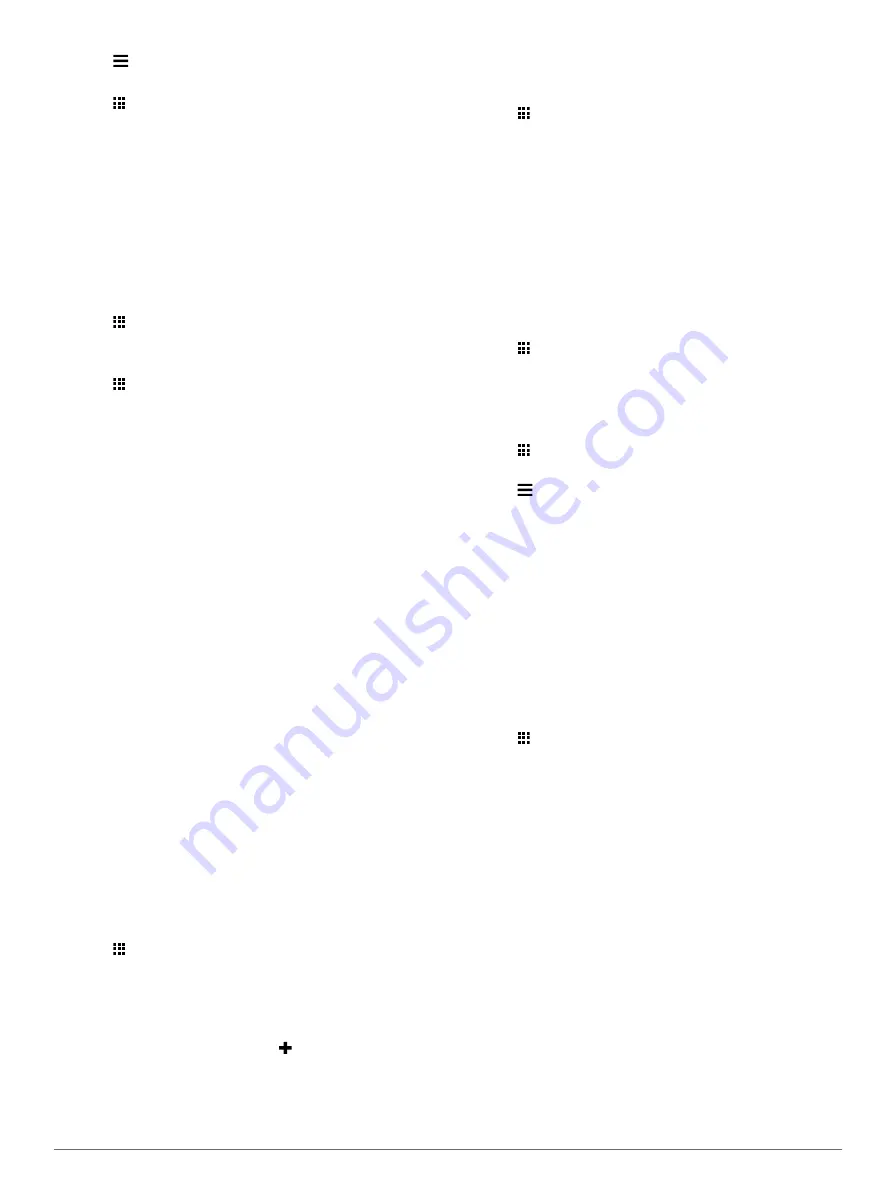
2
Select >
Reset
.
Viewing Fuel Economy Information
1
Select >
ecoRoute™
>
Fuel Economy
.
2
Select a section of the graph to zoom in.
Mileage Reports
Mileage reports provide the distance, the time, the average fuel
economy, and the fuel cost of navigating to a destination.
A mileage report is created for every route that you drive. If you
stop a route on your device, a mileage report is created for the
distance you traveled.
Viewing a Mileage Report
You can view saved mileage reports on the device.
TIP:
You can connect the device to your computer and access
mileage reports in the Reports folder on the device.
1
Select >
ecoRoute™
>
Mileage Report
.
2
Select a report.
Resetting ecoRoute Information
1
Select >
ecoRoute™
>
Vehicle Profile
.
2
Select
Reset
.
Driving Tips
• Drive the speed limit. In most vehicles, you will achieve
optimal fuel economy between 45 mph and 60 mph.
• Drive a consistent speed.
• Brake and accelerate gradually and consistently.
• Avoid stop-and-go traffic and rush hour.
• Do not rest your foot on the brake pedal.
• Use the cruise control.
• Turn your vehicle off instead of idling for temporary stops.
• Combine small trips into one longer trip with multiple stops.
• Turn off the air conditioner and open your windows, unless
you are traveling at high speeds on the highway.
• Tighten your gas cap.
• Park in the shade or in the garage.
• Unload excess weight. Remove unneeded items from your
vehicle.
• Avoid carrying items on your roof. Remove rooftop carriers
and removable racks when not in use.
• Maintain the recommended tire pressure. Check tire
pressure regularly and before long trips.
• Keep your vehicle well-tuned, and follow the vehicle
manufacturer’s recommended maintenance intervals.
• Change your oil, oil filters, and air filters regularly.
• Use the lowest recommended suitable grade of fuel. Use
biofuels when feasible, such as E85 and biodiesel.
Planning a Trip
You can use the trip planner to create and save a trip with
multiple destinations.
1
Select >
Trip Planner
.
2
Select
New Trip
.
3
Select
Select Start Location
.
4
Finding a Location by Category
5
Select
Select
.
6
To add additional locations, select .
7
Select
Next
.
8
Select
Save
.
9
Enter a name, and select
Done
.
Scheduling a Trip
You can use the trip planner to create and save a trip with
multiple destinations.
1
Select >
Trip Planner
.
2
Select a trip.
3
Select a location.
4
Select an option:
• Select
Departure Time
.
• Select
Arrival Time
.
5
Select a date and time, and select
Save
.
6
Select
Duration
.
7
Select the amount of time you will spend at the location, and
select
Save
.
8
If necessary, repeat steps 3–7 for each location.
Navigating to a Saved Trip
1
Select >
Trip Planner
.
2
Select a saved trip.
3
Select
Go!
.
4
Select your next destination, and select
Start
.
Editing a Saved Trip
1
Select >
Trip Planner
.
2
Select a saved trip.
3
Select .
4
Select an option:
• Select
Rename Trip
.
• Select
Edit Destinations
to add and delete a location, or
to change the order of locations.
• Select
Delete Trip
.
• Select
Optimize Order
to arrange the stops on your trip
in the most-efficient order.
Viewing Previous Routes and Destinations
Before you can use this feature, you must enable the travel
history feature (
).
You can view your previous routes and places you have
stopped on the map.
Select >
Where I've Been
.
Data Management
You can store files on your device. The device has a memory
card slot for additional data storage.
NOTE:
The device is not compatible with Windows® 95, 98,
Me, Windows NT®, and Mac® OS 10.3 and earlier.
About Memory Cards
You can purchase memory cards from an electronics supplier,
or purchase pre-loaded Garmin mapping software
(
). In addition to map and data storage, the
memory card can be used to store files such as maps, images,
geocaches, routes, waypoints, and custom POIs.
Installing a Memory Card
The device supports microSD™ and microSDHC memory cards.
1
Insert a memory card into the slot on the device.
2
Press it in until it clicks.
Connecting the Device to Your Computer
You can connect the device to your computer using a USB
cable.
10
Data Management






















